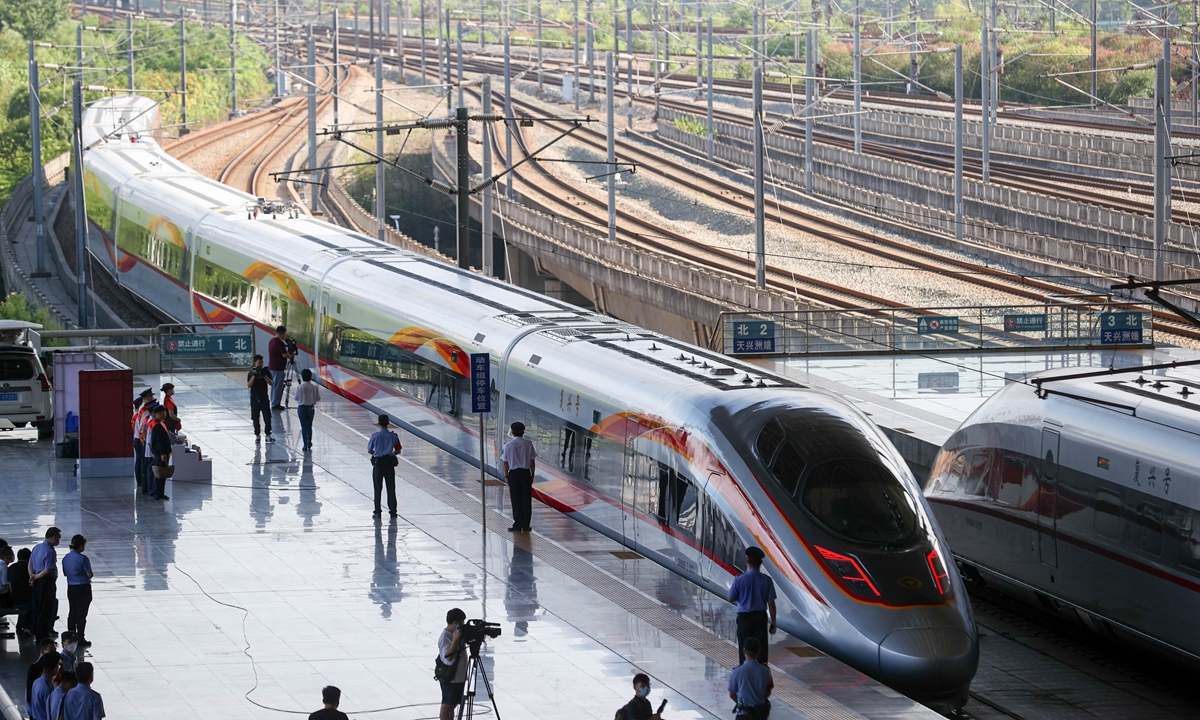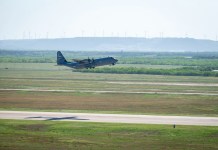China Railway announced that it had successfully completed performance tests of new high-tech parts essential to CR450 high-speed trains at speeds exceeding 400 kilometers per hour.
The train is claimed to be the fastest in the world, and the Chinese Railway emphasized that this achievement represents another significant development in China’s industry-leading high-speed rail technology.
According to China Railway, testing was done along a section of the railway from Fuqing to Qianzhou in East China’s Fujian Province to fasten the development of a new generation of high-speed trains that are faster, safer, more environmentally friendly, energy-efficient, and intelligent.
High-speed rail systems combine speed and effectiveness, and these trains have a long history, ranging from the Japanese Shinkansen to the French TGV to the Chinese High-Speed Railway network, which has given China the reputation of being the country with the largest railway network.
The fastest high-speed train running speed in China right now is 350 km/h, the highest high-speed rail operating speed in the world. According to reports, the highest operational speeds for high-speed trains in Japan and France are set at 320 kilometers/hour.
Going a step forward, China launched the CR450 science and technology innovation project to develop an even faster train.
Earlier this year, China Daily cited Zhao Hongwei, chief researcher of the China Academy of Railway Sciences, as saying that a more advanced bullet train, the CR450, with a top operating speed of 400 kilometers per hour and an experimental speed of up to 450 kilometers per hour is getting ready.
Previously, China’s 14th Five-Year Plan (2021–25) outlined research and development plans for the speedier bullet train, according to the representative. The national railway operator, China State Railway Group, published general provisional technical specifications for the CR450 EMU in January last year.

The recent testing is a massive step towards realizing those plans. As per the latest announcement, at a single-train speed of 453 kilometers/hour and a relative velocity of 891 kilometers/hour, the test train successfully traversed the Meizhou Bay cross-sea bridge on June 28.
The next day, the test train ran in the Haiwei Tunnel at 420 kilometers/hour for a single train and 840 kilometers/hour for a relative speed.
The new technology’s components passed rigorous performance tests, showing great results across a range of metrics. According to China Railway, this accomplishment represents a critical turning point in the creation of the CR450 high-speed train and lays the groundwork for the execution of the CR450 Technology Innovation Project.
The new technology’s components passed rigorous performance tests, showing great results across a range of metrics. The train would cut the journey from Beijing to Shanghai in half, taking only 2.5 hours at a speed of 400 kilometers/hour.
Although China is leading the effort at high-speed railways that provide an affordable and convenient alternative to aviation, other global powers have also developed high-speed trains that merit a mention.
World’s Fastest Trains
With a maximal operating speed of 460 kilometers/hour and an average speed of 251 kilometer/h, the Shanghai Maglev, also known as the Shanghai Transrapid, tops the list.
It has a mind-blowing top speed of 501 kilometers/hour. However, it is not a high-speed train typically run in China; it’s a maglev train.
It levitates above the rail using electromagnetic energy, which eliminates friction and makes for exceptionally smooth and quiet movement. The Shanghai Maglev is owned and run by the Shanghai Maglev Transportation Development Company.
Another one of the fastest trains in the world is also Chinese. A line of fast trains is called the China Railway (CR) Fuxing and can reach speeds of 420 kilometers/hour in testing but typically travel at 350 kilometers/hour.
Without any patented or licensed technology from other rolling stock producers, the Fuxing models are the first fully domestically-built high-speed models in China.

The ICE 3, or Intercity-Express 3, is a family of high-speed electric multiple-unit trains manufactured by Siemens and Bombardier. This high-speed railway is run by Germany and The Netherlands.
German ICE 3 trains can travel at a maximum speed of 320 kilometers/hour on high-speed rail lines, but class 403 is permitted to travel at a maximum speed of 330 kilometers/hour on the high-speed route between Frankfurt and Cologne to avoid delays.
Another European and iconic French railway called the Train à Grande Vitesse, or TGV. This pioneer of high-speed rail in Europe began operations on the continent’s first high-speed railway in France and has since surpassed records for highest speeds numerous times.
The 16th trainset of the TGV Sud-Est set a record speed of 380 kilometers/hours in 1981. A modified TGV Atlantique 325 train set a new record speed of 515.3 kilometers/hour just over ten years later, in 1990.
A modified TGV POS with two powered bogies similar to the AGV prototype broke this record in 2007, setting the current record of 574.8 kilometers/ hour.

The next train on the list is the most popular in the world-the Japanese Shinkansen, also referred to as the bullet train. The original Shinkansen trains now called the 0 series, were put into operation in 1964 and had a top operating speed of 220 kilometers/hour.
The contemporary Hitachi Rail and Kawasaki Heavy Industries E5 and H5 Series can operate at a top speed of 320 kilometers/hour.
Next up on the list is another one in Asia, South Korea. The high-speed rail network in South Korea is operated by Korail, the country’s national railway company. Korea Train Express, also called KTX, started running in 2004.
On the South Korean high-speed rail network, 71 trainsets can carry up to 363 passengers each and accelerate from 0 to 300 km/h in 316 seconds.
The new generation HEMU-430X prototype broke the previous Korean rail speed record of 352.4 kilometers/hour established by a KTX-Sancheon HSR-350x train in 2013 by traveling 421.4 kilometers/hour.

Going back to Europe, another high-speed railway that merits a mention is the Frecciarossa, or ETR1000, jointly developed by Hitachi Rail Italy and Alstom for Italian state railway operator Trenitalia. Additionally operating in Spain is the Frecciarossa, popularly known as the red arrow.
The ETR1000 trainsets, reportedly created in answer to Italo, a private high-speed rail operator in Italy, accommodate 457 passengers in eight-car, non-articulated trains that are 200 meters long and have an engineered top speed of 400 kilometers/hour.
Although the trains may achieve 300 kilometers/hour when used, one ETR1000 set surpassed 389 kilometers/hour when tested in 2015.
High-speed rail will keep getting better and expanding. Despite obstacles, several high-profile projects seem inevitable. These include high-speed rail in California, Australia’s difficult high-speed rail history, and probably most infamously, the UK’s perpetually delayed HS2 project.
- Contact the author at sakshi.tiwari9555 (at) gmail.com
- Follow EurAsian Times on Google News





